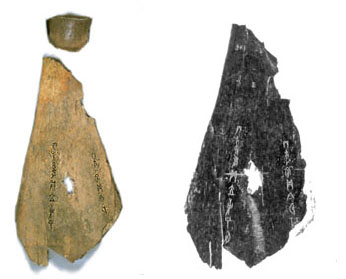 |
|
|
 |
|
|
Inscribed Oracle
Bones: Ox Scapula Fragments Shang
dynasty (ca. 1600�ca. 1100 b.c.e.),
undated, from the reign of the king Wu Ding (ca. 1198�ca. 1189 b.c.e.) Two
fragments; dimensions vary (a: 4.8 x 7.5 cm; b: 27.7 x 15.2 cm) Inventory number: Jiagu 5402, 5403 Oracle-bone
inscriptions are the earliest form of recognizable writing in China.� They are most commonly called jiagu wen
(writing on shell and bone), which is short for guijia shougu wenzi (writing
on turtle shell and animal bone), but are also known as qi wen (inscribed script), zhenbu wenzi
(oracular script), or Yinxu wenzi (script from the Yin ruins),
Yinxu being the name used since at least the Han dynasty (206 b.c.e.�220 c.e.) for Yin, the final capital of the Shang, after its
destruction.� Variations exist in the
structural configuration and size of the script, while the characters were
written in many different ways.� In
general, however, the inscriptions are placed vertically in columns and read
from top to bottom, with the arrangement of the characters depending on the
shape of the turtle shell or animal bone used.�
Because thin strokes are predominant in oracle-bone inscriptions, the
characters often appear to be written rather than incised. Since
their initial identification by scholars in 1899 and the subsequent discovery
of their source at Xiaotun, Henan Province, in 1908, more than 200,000 oracle bones
or bone fragments have been unearthed from Xiaotun alone; 50,000 of these bear
decipherable inscriptions, and still more have been found elsewhere in
China.� Of the more than 3,000 graphs
found on oracle bones, about 800 can be interpreted.� The National Library of China has a very large collection of
inscribed oracle bones, numbering 34,512 individual pieces.� The Library also possesses 70,677 sheets of
rubbings taken from inscribed oracle bones.�
Most of these have been published in the 13-volume Jiagu wen he ji (1978�1983). |
 |